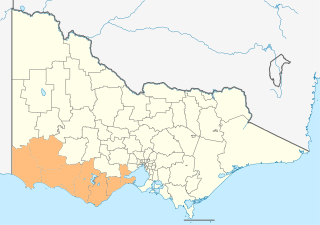Lake Corangamite, a hypersaline endorheic lake, is located near Colac in the Lakes and Craters region of the Victorian Volcanic Plains of south-west Victoria, Australia. The lake's salinity levels have increased dramatically as the lake level has dropped in recent decades. It is Australia's largest permanent saline lake, covering approximately 230 square kilometres (89 sq mi) with a circumference of 150 kilometres (93 mi). It forms part of the Ramsar-listed Western District Lakes wetland site. The indigenous name of the lake is recorded as Kronimite.

Joseph Tice Gellibrand was the first Attorney-General of the British colony of Van Diemen's Land where he gained notoriety with his attempts to establish full rights of trial by jury. He became an integral part of the Port Phillip Association, producing the Batman Treaty in an attempt to obtain extensive land-holdings from the local Aboriginal people around Port Phillip. He was also later part of an ill-fated expedition into the region west of Geelong where he disappeared and was assumed to have been killed by Aboriginal people in the Otway Range.
Cape Otway is a cape and a bounded locality of the Colac Otway Shire in southern Victoria, Australia on the Great Ocean Road; much of the area is enclosed in the Great Otway National Park.
The Kennet River, now commonly spelt Kennett River, is a perennial river of the Corangamite catchment, located in the Otways region of the Australian state of Victoria.

The Parker River is a perennial river of the Corangamite catchment, located in the Otways region of the Australian state of Victoria.
The Johanna River is a perennial river of the Corangamite catchment, located in the Otways region of the Australian state of Victoria.

The Aire River is a perennial river of the Corangamite catchment, located in the Otways region of the Australian state of Victoria.
The Ford River is a perennial river of the Corangamite catchment, located in the Otways region of the Australian state of Victoria.
The Calder River is a perennial river of the Corangamite catchment, located in the Otways region of the Australian state of Victoria.
The Geary River is a perennial river of the Corangamite catchment, located in the Otways region of the Australian state of Victoria.
The Elliott River is a perennial river of the Corangamite catchment, located in the Otways region of the Australian state of Victoria.

The Barham River is a perennial river of the Corangamite catchment, located in the Otways region of the Australian state of Victoria.
The Grey River is a perennial river of the Corangamite catchment, located in the Otways region of the Australian state of Victoria.

The Wye River is a perennial river of the Corangamite catchment, located in the Otways region of the Australian state of Victoria.

The Cumberland River is a perennial river of the Corangamite catchment, located in the Otways region of the Australian state of Victoria.
The St George River, or sometimes incorrectly Saint George River, is a perennial river of the Corangamite catchment, located in the Otways region of the Australian state of Victoria.

The Anglesea River is a perennial river of the Corangamite catchment, located in the Otways region of the Australian state of Victoria.
The Carlisle River is a perennial river of the Corangamite catchment, located in the Otways region of the Australian state of Victoria.
The Curdies River is a perennial river of the Corangamite catchment, located in the Otways region of the Australian state of Victoria.

The Barwon South West is an economic rural region located in the southwestern part of Victoria, Australia. The Barwon South West region stretches from the tip of the Queenscliff Heads to the border of South Australia. It is home to Victoria’s largest provincial centre, Geelong and the major centres of Aireys Inlet, Apollo Bay, Camperdown, Colac, Hamilton, Lorne, Port Campbell, Port Fairy, Portland, Torquay and Warrnambool. It draws its name from the Barwon River and the geographic location of the region in the state of Victoria.








